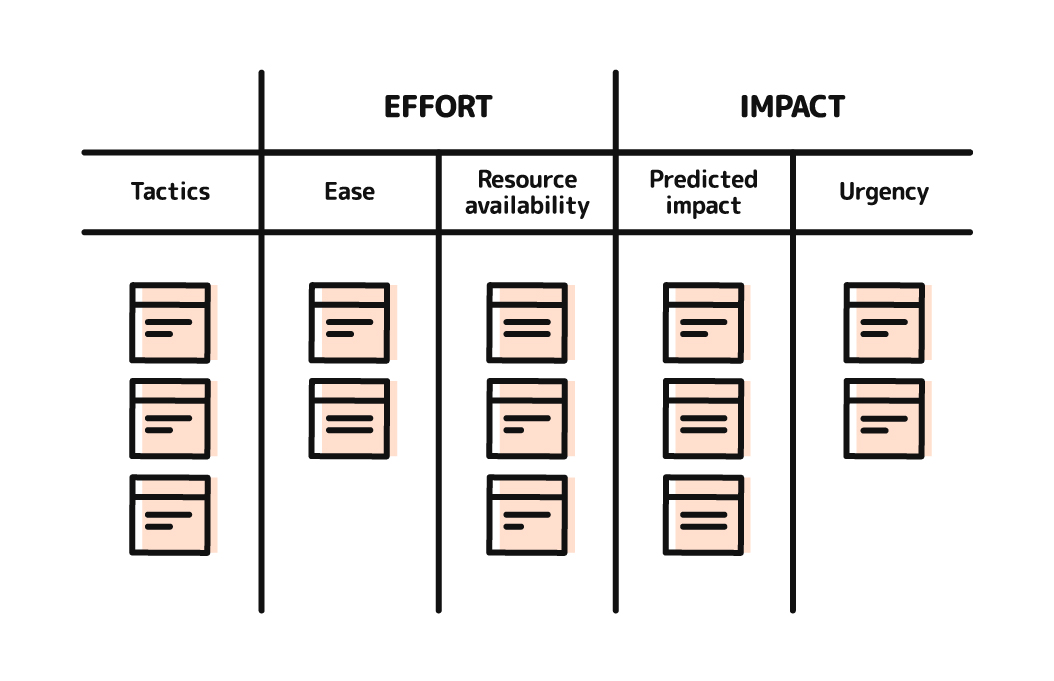How to prioritise digital marketing tactics
In this guide, we highlight the key benefits of prioritising tactics, introduce two proven prioritisation models (one simple and one more advanced), plus show you what to do once you have your prioritised list.

Contents
- A common problem
- When do you typically prioritise tactics?
- Why prioritise your tactics?
- Prioritisation method one: The Boston Matrix
- Prioritisation method two: The Decision Matrix
- Download a FREE Decision Matrix template
- Video: why prioritisation is important
- What's next? The Now, Next, Later model
- Digital strategy case study
A common problem
The one phrase we never hear a client utter is “I’ve got nothing to do and need more work for my team”. In fact, if anything, it’s usually “Help I’ve got so much to do and don’t know where to start!”.
A common problem for many digital marketing teams is exactly this – there is a huge volume of tactical activity, both ‘BAU’ and new ideas, but not enough time in the day (or people in the team) to do that work.
Many people we speak to have a huge backlog and are working through in order, but often haven’t stopped to consider whether that’s the right order. The good news, however, is there is a solution – prioritisation.
When do you typically prioritise tactics?
The most common time to prioritise tactics is when you have a large selecting of tactics to complete, and there is no immediately clear direction on which to work on first. Equally, if there are a lot of opinions or internal politics around the organisation, it’s a great way of getting everyone to input into how tactics are prioritised.
A few examples of activity that you may need to utilise prioritisation techniques:
- Digital marketing strategy – when you’re planning your next 12 months of activity there’s likely to be a large number of tactics to work on across several digital teams
- Content strategy - which pages need to be worked on first
- Testing plan - for conversation rate optimisation
Why prioritise your tactics?
Before introducing you to some ways in which you can prioritise tactics, we firstly wanted to outline the benefits of prioritisation.
- Increases productivity – by knowing what tactics you need to work on and in which order, you can work through them better without having to stop and think about what to do next
- Improves team focus and output – as well as providing a focus for you individually, prioritisation can help the whole team or department to see what needs doing and when. This naturally leads to a much better sense of collaboration and level of output
- Makes the best use of available resources – for many digital marketing teams, resources – in the form of people and budgets – can be limited. The exercise of prioritisation means you put this at the front of our mind and work on the things that can be most realistically achieved
- Helps your business case for more budget – related to the point above, prioritising tactics means you are in theory now working on the right things that will drive the most impact
- Removes obsolete ideas – the adage is, “there’s no such thing as a bad idea”, which is true to an extent. However, some ideas should be saved for another time as they are just not as impactful as others
- Helps get executive leadership buy-in – having a clear and visible prioritised plan means that people from across the organisation, including senior and executive teams, can see exactly what’s been worked on and know that it’s the tactics deemed to be the most important
- Makes work more enjoyable – this is less tangible from a business point of view, however, is important. If you are working on the most important things, then this can help you to get much more satisfaction back. This is reinforced when you see the right tactics having much more of an impact. Also, a clear, prioritised list reduces the stressful element of “are we working on the right things?”
Prioritisation method one: The Boston Matrix
Prioritising a long list of tactical ideas may seem daunting at first; however, there are several established methods to help you make this simple. One of these is the Boston Matrix – a model devised by the Boston Consulting Group originally designed to help prioritise products for development.
The layout of the Boston Matrix
Fresh Egg has taken this model and applied it to the prioritisation of tactics by the two scales of ‘impact’ versus ‘effort’.

By adding your tactics to one of the ‘squares’, you can then quickly see how much of a priority it is.
Each of the squares provides you with an indication of the status of the tactic:
- Quick wins – these tactics are higher impact and lower effort; therefore you should be able to implement these fairly quickly and easily
- Bigger projects – the same higher impact, but more effort means these tactics need a bit more thought and planning, as they are likely to require more time and potentially budget
- Friday afternoons – this group of tactics are predicted to have a lower impact, but on the plus side are relatively quick and easy to do (hence the ‘Friday afternoons’ label). You can incorporate these into your working week, but use them more to fill gaps in time
- Park for later – the final quadrant includes the tactics that not only are thought not to drive much impact but also may take more time and budget to achieve. As a result, it is likely these will be ignored, for now; however, you may want to revisit them in the future as something may change that means they are now worth pursuing
This model is based more on ‘gut feel’ rather than any advanced decision making and therefore whilst is a simple way to prioritise, may require some further prioritisation before you fully plan your roadmap of activities.
You will also see that there is a variation of the actual effort and impact levels within each square. Therefore after you have done this initial exercise, you will likely need further discussion to plan the final order.
How to prioritise using the matrix
One simple way is to gather a group of people together, draw up the matrix axis on a whiteboard, list out your tactics onto Post-Its.
You then start to discuss each one in turn and work out which square it best fits, plus whereabouts in the square it should be placed.
Stick each one up onto the matrix and then spend some time sense-checking they are in the right place at the end.
If your group is too large, then there is a danger that the louder people will rule the conversation and the task will seem a bit more arduous (and take a lot longer). In this instance – probably with a group of more than 6-9 people – we suggest splitting people into smaller groups.
These smaller groups can either prioritise their own set of tactics, or they can prioritise the same tactics, then as a whole group, you can compare what people thought.
Prioritisation method two: The Decision Matrix
While the Boston Matrix is a simple and good method to use, you may find that your tactics need to have much more consideration as to their complexities. This is where the Decision Matrix comes in.
The Decision Matrix works by allocating a score against specific criteria for each tactic. Once all tactics are scored, you can then sort these and clearly see which tactics are judged to be the most important to work on.
The scoring criteria
There are several different variations on criteria typically; however, Fresh Egg has adopted using the following four, generally using a scale of 1-5.
- Time/resource/budget required – how much of these are needed?
- Resource availability – do you have the current people (or skills) to do this (either internally or with an outside partner)?
- Predicated impact on primary KPIs – thinking about what you need to achieve (your KPIs), how much do you think the tactic will help to impact these positively?
- Urgency – how quickly do you feel this tactic needs to be started?
For the first criteria, the scale used is where 1 = ‘most’ and 5 equals ‘least, however for the other three criteria this is reversed, with 1 = ‘least’ and ‘5’ = most. This is because the first criteria are more of a negative factor, and the others are positive.

How to create a Decision Matrix
The simplest way to do this is to use Excel or Google Sheets and list all your tactics in one column, then add columns for each of your scoring criteria (plus a ‘total score’ column).
Again, either in small groups or a larger one, you discuss each tactic and allocate it a score against each criteria, then total these up and sort the list from the highest score (highest priority) to lowest.
An alternative method is to get people to score each tactic individually; then these are combined and averaged out to get the score.
Download our FREE Decision Matrix template
Customising the Decision Matrix
To get the most out of the Decision Matrix, it can be useful to swap out the standard criteria and come up with your own set of rules. Doing this allows each team from around the organisation a chance to input into the process and can allow for easier sign-off of tactics once the Decision Matrix has been completed.
We’ve found that this is best achieved in a workshop where stakeholders from around the business can get together in a room and decide on the criteria and weighted scores collectively.
As an example, we recently worked with a large health charity on creating a decision matrix that had input from clinical, offline, content and leadership teams where we workshopped what criteria should be used and the individual weighting of each criteria. Rather than initially being confined to a spreadsheet, this can be done physically using cards and allows the testing of the criteria to be much more interactive.
It’s okay for the criteria to fail the first few times, use the session to get everyone to agree on the criteria and the weighted scores and then give someone in the team the action of creating the Decision Matrix in Excel or Google Sheets for the team to review later.
What’s next? The Now, Next, Later model
So, you’ve worked on your method of prioritisation you now need to work out when you are going to work on these tactics.
We use a simple method to help plan when the activity gets worked on called ‘Now, Next, Later’.

We find it useful to attach a timeframe of completion to Now, Next, Later. As an example:
- Now – all tactics will be completed within one month
- Next – all tactics will be completed within 2-6 months
- Later – all tactics will be completed within 7-12 months
These don’t need to be set in stone, your Now tactics could be completed within a week, and your Later tactics could be in 5 years, what’s important is that they represent a realistic timeframe for when tactics can be completed.
Once you know the timeframes you can complete tactics in you can begin assigning them to Now, Next or Later and it will give you and the wider team a clear understanding of when the most important tactics will be completed.
Loading
Talk to us about your digital challenges
Tell us your needs and we'll be in touch
Discover our other resources
Do you have a challenge we can help with?
Let's have a chat about it! Call us on 01903 337 580